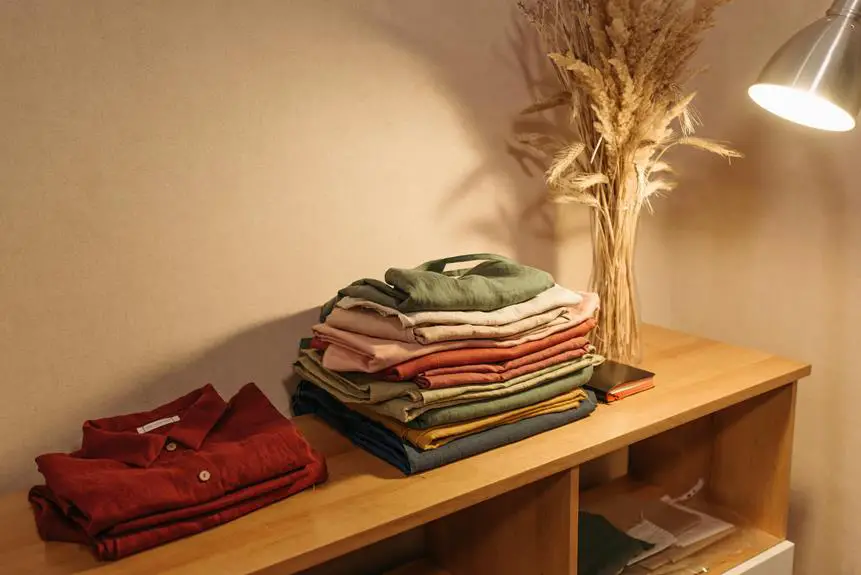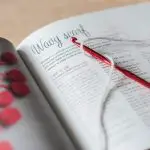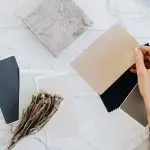Do you want to unlock the potential of your fabrics?
Bonded clothing, like a seamless fusion, brings together the best of two materials to create a stronger, more versatile fabric. This process involves joining two or more layers using heat, adhesives, or other bonding agents, resulting in enhanced durability, flexibility, and performance.
Bonded fabrics benefit from increased strength, improved stretch, breathability, and moisture management. They also offer water resistance and weather protection, making them ideal for various applications in fashion and beyond.
Understanding bonded clothing and its benefits can empower you to make informed choices when selecting materials for your projects and creations.
Key Takeaways
- Bonded clothing fuses different materials together to create stronger fabrics.
- Bonding improves fabric durability, tensile strength, and abrasion resistance.
- Bonded fabrics offer enhanced moisture resistance and advanced moisture management.
- Bonded fabrics are used in various applications, including performance wear and everyday clothing, for their durability and aesthetics.
Understanding Bonded Clothing
Understanding bonded clothing involves examining the process of bonding fabrics and the resulting characteristics. Bonded clothing technology has revolutionized the way fabrics are utilized in the fashion industry. By fusing together different materials, such as textiles, plastics, and metals, manufacturers are able to create innovative fabrics with enhanced properties. This process involves using adhesives, heat, or ultrasonic welding to bond the materials together, resulting in fabrics that exhibit unique qualities like increased durability, water resistance, and stretch. These fabric innovations have opened up new possibilities for designers, allowing them to create garments that aren't only stylish but also functional and practical.
The technology behind bonded clothing has also led to the development of lightweight, breathable, and versatile fabrics that are ideal for activewear and outdoor apparel. Additionally, bonded fabrics can be designed with specific characteristics, such as insulation or moisture-wicking properties, making them suitable for a wide range of applications. Understanding the intricacies of bonded clothing technology is essential for anyone seeking to stay abreast of the latest advancements in fabric innovation and fashion design.
The Bonding Process Explained
The bonding process in creating fabrics involves the fusion of different materials using adhesives, heat, or ultrasonic welding to produce innovative textiles with enhanced properties.
The manufacturing techniques for bonded fabrics include:
- Adhesive Bonding: This method involves applying a bonding agent to one or both fabric surfaces and then using heat or pressure to create a strong bond between the materials.
- Heat Bonding: In this process, heat is utilized to melt thermoplastic fibers or films, which then bond with other fabrics to create a seamless and durable composite material.
- Ultrasonic Welding: Ultrasonic vibrations are used to generate heat, causing the materials to fuse together, resulting in a strong and flexible bond without the need for adhesives or additional materials.
- Seam Sealing: This technique involves using heat and pressure to apply seam tape or adhesives to the fabric, creating a waterproof and durable bond that prevents water from penetrating the seams.
These manufacturing techniques play a crucial role in creating bonded fabrics with superior strength, flexibility, and performance for various applications in the fashion, sportswear, and technical textile industries.
Advantages of Bonded Fabrics
When it comes to bonded fabrics, there are several advantages worth considering.
These fabrics offer improved durability, making them more resistant to wear and tear.
Additionally, they provide enhanced moisture resistance, ensuring that the fabric remains in good condition even in challenging environments.
Improved Fabric Durability
To enhance fabric durability, bonding clothing materials efficiently strengthens the overall structure. This process offers several advantages that contribute to the increased longevity and resilience of the fabric:
- Enhanced resistance to tearing and fraying, minimizing the likelihood of damage during wear and laundering.
- Improved tensile strength, ensuring the fabric can withstand stretching and pulling without weakening or distorting.
- Increased abrasion resistance, reducing the potential for wear and tear from friction and repeated use.
- Better retention of shape and form, maintaining the fabric's original appearance and structural integrity over time.
These benefits make bonded fabrics a desirable choice for garments and textiles where durability and longevity are paramount.
Enhanced Moisture Resistance
Experience improved moisture resistance in bonded fabrics, ensuring greater comfort and protection in various environments.
Bonded fabrics offer advanced moisture management, making them ideal for performance wear during intense physical activities or outdoor adventures.
The fabric technology used in bonded clothing enhances its ability to repel moisture, keeping you dry and comfortable even in challenging conditions.
Whether you're hiking, running, or engaging in other outdoor activities, bonded fabrics provide reliable protection against sweat and external moisture, allowing you to focus on your performance without feeling weighed down or uncomfortable.
This moisture resistance is achieved through innovative bonding techniques that create a barrier against water penetration while still allowing moisture vapor to escape, resulting in superior comfort and performance during your active pursuits.
Enhanced Durability and Strength
By bonding fabrics together, you can significantly enhance their durability and strength, making them more resistant to wear and tear over time. This process involves using advanced fabric technology to create a bond that reinforces the strength of the material.
Here's how bonded clothing benefits fabric durability and strength:
- Enhanced resistance to abrasion: Bonding fabrics can create a protective layer that reduces the impact of friction, increasing the fabric's ability to withstand rubbing and scraping.
- Improved tensile strength: The bonding process helps distribute force across the fabric, making it less prone to tearing or stretching under pressure.
- Increased dimensional stability: Bonded fabrics are less likely to shrink, warp, or distort, maintaining their original shape and structure for longer periods.
- Enhanced seam strength: When fabrics are bonded, the seams become more durable, reducing the risk of fraying or seam failure.
Bonded clothing not only offers enhanced durability and strength but also provides a more resilient and long-lasting fabric for various applications.
Improved Stretch and Flexibility
With bonded clothing, you'll experience improved stretch and flexibility through the integration of advanced fabric bonding technology, allowing the material to move with your body more naturally. This enhanced stretch and flexibility are achieved through innovative fabric bonding techniques that enable the garment to better conform to your movements. The use of bonded seams and panels reduces the resistance typically experienced with traditional stitching, resulting in improved performance and range of motion. The strategic placement of bonded areas in key areas of the garment further enhances its ability to stretch and flex, providing a more comfortable and unrestricted wearing experience.
The innovation in fabric bonding not only improves the stretch and flexibility of the clothing but also contributes to its overall performance. By allowing the fabric to move more naturally with your body, bonded clothing enables you to engage in a wider range of activities without feeling constrained by your attire.
This advancement in fabric technology represents a significant step forward in creating garments that not only look stylish but also support your active lifestyle with enhanced comfort and flexibility.
Breathability and Moisture Management
To enhance your wearing experience, bonded clothing optimizes breathability and moisture management, ensuring comfort and performance during various activities.
Bonded fabrics incorporate advanced breathability technology, allowing air to circulate through the material, keeping you cool and dry.
Additionally, moisture-wicking fabrics efficiently pull sweat away from your skin, preventing the discomfort of wet, clammy clothing. This advanced moisture management system ensures that you remain dry and comfortable, even during intense physical exertion.
Furthermore, the breathability technology in bonded clothing helps to regulate your body temperature, preventing overheating and allowing you to maintain your focus and stamina.
The combination of these features in bonded clothing creates an optimal environment for your body, allowing you to push your limits without being hindered by discomfort or moisture buildup.
Water Resistance and Weather Protection
When it comes to water resistance and weather protection, bonded clothing offers enhanced durability against the elements, ensuring your fabric stays strong and intact.
Additionally, the bonding process can improve breathability and comfort while still providing resistance to wind, making it a versatile choice for various weather conditions.
This means you can rely on bonded clothing to keep you protected and comfortable no matter what the weather throws at you.
Enhanced Fabric Durability
For improved fabric durability, bonded clothing enhances water resistance and weather protection, ensuring lasting performance in various conditions. When fabric bonding is employed to enhance durability, it results in the following benefits:
- Increased water resistance: Bonded clothing creates a barrier that repels water, keeping you dry and comfortable even in wet conditions.
- Enhanced weather protection: The bonded fabric provides a shield against wind, rain, and snow, making it ideal for outdoor activities in varying climates.
- Improved longevity: Bonded clothing increases the fabric's resistance to wear and tear, ensuring it can withstand frequent use and maintain its quality over time.
- Versatile performance: The enhanced durability of bonded clothing allows for reliable performance in a range of activities, from hiking and camping to everyday wear.
These features make bonded clothing a valuable choice for those seeking long-lasting, high-performance textiles.
Improved Breathability and Comfort
You'll find that bonded clothing not only enhances water resistance and weather protection but also improves breathability and comfort, making it an ideal choice for various activities in different climates. Bonded fabric technology allows for improved performance in terms of breathability, ensuring that moisture and heat are efficiently managed to keep you comfortable during physical activities. Additionally, bonded clothing provides better weather protection, shielding you from wind and rain while maintaining breathability. This combination of features makes bonded clothing a versatile option for outdoor adventures or everyday wear in changing weather conditions.
| Improved Breathability and Comfort | Water Resistance and Weather Protection | Enhanced Fabric Durability |
|---|---|---|
| Efficient moisture and heat management | Shields from wind and rain | Greater resistance to wear and tear |
| Keeps you comfortable during activities | Maintains breathability | Longer lifespan of the fabric |
| Ideal for various climates and activities | Versatile for outdoor adventures | Suitable for rugged use |
| Allows for better air circulation | Protects from harsh weather conditions | Retains quality over time |
Resistant to Wind
Bonded clothing provides wind resistance and weather protection, ensuring you stay comfortable and dry in challenging outdoor conditions. This feature is essential for outdoor performance, especially in unpredictable weather. Here's how bonded clothing achieves wind resistance and weather protection:
- Specialized Bonding Technology: The bonding process creates a barrier that prevents wind from penetrating the fabric, keeping you shielded from harsh gusts.
- Water-Repellent Finishes: Many bonded fabrics are treated with water-resistant finishes to repel moisture and keep you dry in rainy or snowy conditions.
- Sealed Seams: Bonded clothing often features sealed seams that prevent water from seeping through the stitching, enhancing the garment's weather protection.
- Breathable Construction: Despite its wind resistance and weather protection, bonded clothing maintains breathability, allowing perspiration to escape while blocking external elements.
Applications and Fashion Innovations
Innovators frequently incorporate bonded fabrics into their designs to enhance the durability and structure of clothing, elevating the fashion industry's standards. This application of textile technology has revolutionized the creation of performance wear, offering a wide range of benefits for various activities.
The seamless integration of bonded fabrics in sportswear provides unparalleled support and flexibility, making them ideal for intense physical activities. Moreover, fashion innovation has seen the utilization of bonded fabrics in everyday clothing, offering not only enhanced durability but also a sleek and modern aesthetic.
The use of bonded fabrics in athleisure wear has further blurred the line between activewear and casual clothing, catering to the growing demand for versatile and stylish apparel. Additionally, the application of bonded fabrics has extended to outerwear, creating lightweight yet weather-resistant jackets and coats.
This innovative approach not only enhances the functionality of clothing but also allows designers to explore new possibilities in creating garments that seamlessly blend performance and style.
Frequently Asked Questions
Can Bonded Clothing Be Repaired if the Bonding Becomes Damaged?
If the bonding in your clothing becomes damaged, it can often be repaired. Proper maintenance and care can help ensure the durability of the bonding, allowing for easier repair and extending the lifespan of the garment.
How Does Bonded Clothing Compare to Traditional Sewing Methods in Terms of Cost and Production Time?
When comparing bonded clothing to traditional sewing methods, the cost comparison shows that bonded clothing can be more economical due to reduced labor and material expenses. Additionally, production time efficiency is improved with bonded clothing.
Are There Any Environmental Considerations to Take Into Account When Using Bonded Fabrics?
When using bonded fabrics, consider the environmental impact. Look into sustainability initiatives to ensure responsible production. Understand the implications of using these materials on the environment and make informed decisions.
Can Bonded Fabrics Be Recycled at the End of Their Lifespan?
Yes, bonded fabrics can be recycled at the end of their lifespan. This process involves separating the different layers of the bonded fabric and reusing the individual materials, contributing to a more sustainable approach to clothing production.
Are There Any Special Care Instructions for Maintaining the Bonding on Bonded Clothing?
To maintain the bonding on bonded clothing, follow special care instructions for maintenance. Avoid high heat, harsh chemicals, and excessive friction to prevent damage. Repair any damaged bonding promptly to prolong the lifespan of your clothing.
- Tetron Fabric for Marine Applications: Durability and Use Cases - June 18, 2025
- Tetron Fabric for Outdoor Furniture: Weather Resistance and Care - June 18, 2025
- Tetron Fabric for Wall Coverings: Style and Application Tips - June 18, 2025







